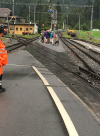It would be interesting to see some primary sources that show maintenance costs in Switzerland vs the UK, rather than relying on what seems to be an anecdote based on a single excursion 15 years ago. These kinds of things usually turn out to be less clear than at first sight.
And, in both UK and Swiss cases, exactly what is and is not accounted for in the headline cost and whether it is 'like-for-like'.

